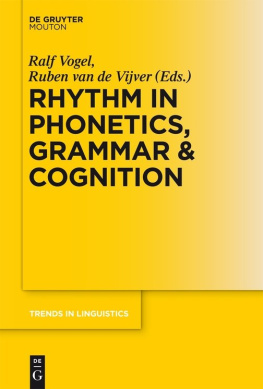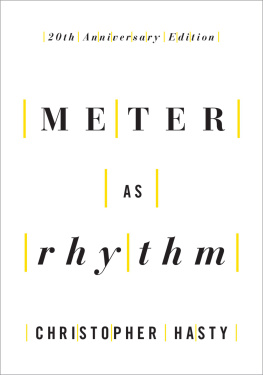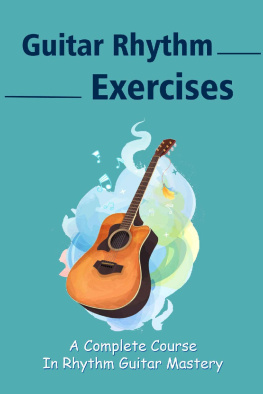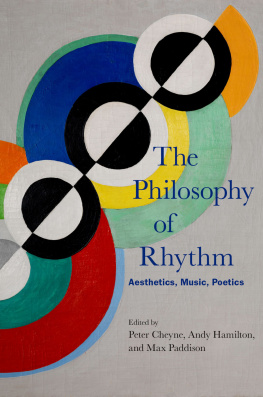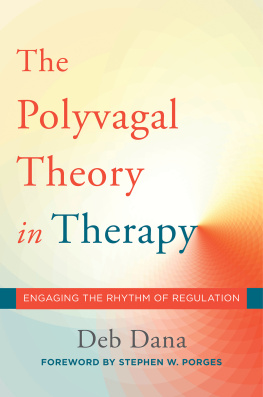Ralf Vogel - Rhythm in Cognition and Grammar
Here you can read online Ralf Vogel - Rhythm in Cognition and Grammar full text of the book (entire story) in english for free. Download pdf and epub, get meaning, cover and reviews about this ebook. year: 2015, publisher: De Gruyter Mouton, genre: Home and family. Description of the work, (preface) as well as reviews are available. Best literature library LitArk.com created for fans of good reading and offers a wide selection of genres:
Romance novel
Science fiction
Adventure
Detective
Science
History
Home and family
Prose
Art
Politics
Computer
Non-fiction
Religion
Business
Children
Humor
Choose a favorite category and find really read worthwhile books. Enjoy immersion in the world of imagination, feel the emotions of the characters or learn something new for yourself, make an fascinating discovery.
- Book:Rhythm in Cognition and Grammar
- Author:
- Publisher:De Gruyter Mouton
- Genre:
- Year:2015
- Rating:4 / 5
- Favourites:Add to favourites
- Your mark:
- 80
- 1
- 2
- 3
- 4
- 5
Rhythm in Cognition and Grammar: summary, description and annotation
We offer to read an annotation, description, summary or preface (depends on what the author of the book "Rhythm in Cognition and Grammar" wrote himself). If you haven't found the necessary information about the book — write in the comments, we will try to find it.
Rhythm in Cognition and Grammar — read online for free the complete book (whole text) full work
Below is the text of the book, divided by pages. System saving the place of the last page read, allows you to conveniently read the book "Rhythm in Cognition and Grammar" online for free, without having to search again every time where you left off. Put a bookmark, and you can go to the page where you finished reading at any time.
Font size:
Interval:
Bookmark:
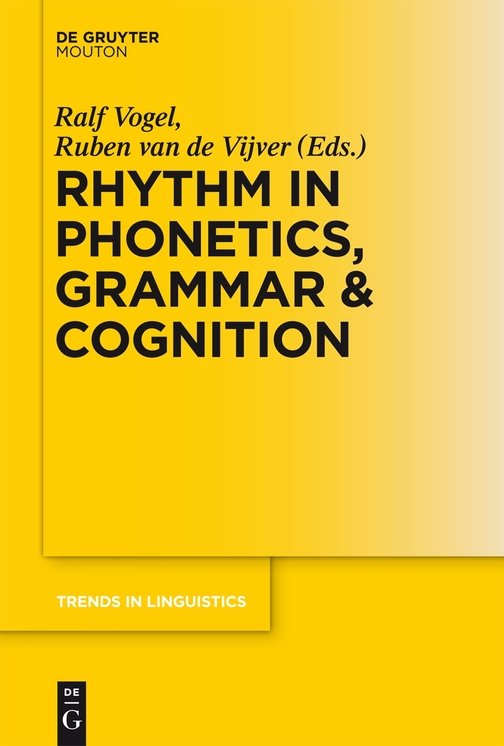
Laszlo Hunyadi
When using the word rhythm we often think of a sequence of pulses of some sort that contribute to the structural sensation of an event. We often associate it with the progress of patterns of sound as represented in music or speech, but rhythm can also be interpreted in a context beyond sound, in the arrangement of visual objects. It can also be associated with events involving non-physical objects such as the sequence of meetings, the appearance and disappearance of certain states of the mind and many other phenomena. All this suggests that what is common in what we associate rhythm with is the systematic occurrence of elements or features in general at distinct spaces, intervals or qualities (the latter may include various shades of color, degrees of intensity, illumination and probably any quality that is a basis for distinction between kinds of elements of objects or stages of the same object).
Rhythm can be essential both in its structural and perceptual/performative sense. The succession of constituting elements of an object (including physical objects and events alike) should be arranged in such a way that is characteristic of the given object, i.e. the intrinsic structural rhythm of elements can define the object itself. On the other hand, the relation between such elements has its significance in representation as well: perceiving a given structure one interprets it through some performative act (in music by musical performance, in language by speech, etc.). Whereas structural rhythm in this sense is an abstract phenomenon, in surface performance it needs physical means of representation. Whereas in music structural rhythm is most straightforwardly conceived to be associated with the temporal organization of successive elements and in language rhythm is usually understood similarly, time is only one means of representation. Even in music and language intensity also plays an important role: the succession of strong and weak accents as well as beats equally contribute to the perception of the underlying rhythmic structure (see the findings of metrical phonology: Liberman 1975, Liberman and Prince 1977, Nespor 1982, 1986, Selkirk 1984, Hayes 1984, 1995; its relation to music: Lerdahl and Jackendoff 1983, and later work). Again, both in music and language further means of representation include the change of pitch values: playing the same musical tone or speaking at the same pitch level for a longer stretch of time gives the sense of monotony and one looses the perception of structure by being unable to capture the structure building rhythm behind the signal. (For a discussion of the cognitive relation between rhythm, timing and tempo in musical performance and perception as contrasted to musical notation cf. Clark 1999, Honing 2001, 2002).
Although time appears to be a fairly general means of representation for rhythm, arrangement of elements across space can also be an important choice, such as in case of architecture or visual art in general. With certain abstract, non-physical objects, like states of mind, emotions etc., systematic variation of degrees of other characteristic properties is a possible form of structural representation, too, just think of, e.g. cases of bipolar disorder. Finally, more than one means of representation often contribute to structural representation in combination: in the case of speech alone, timing, change of F0 and intensity often (but not in a mandatory manner) join in this performative function.
In this work on rhythm we will follow the main assumptions of our earlier proposal (Hunyadi 2009, 2010, and to appear ) regarding the cognitive basis of the representation of structure across modalities. According to this proposal, structure is represented in terms of groups, grouping itself follows certain cognitive principles, and the representation of grouping is structure dependent.
Whatever the physical nature of the means of representation of structural rhythm, rhythm can be conceived as the product of grouping . Namely, rhythm is always about the succession of more than one, actually more than two elements of some sort, and this succession needs to be structured. Structure means that there must be some boundary between the elements, consequently, a rhythmic structure always involves at least two groups of elements. Since, accordingly, the minimal number of elements involving two groups is three, the minimal rhythmic pattern is such that one group consists of two elements and the other group consists of just one element (this single-element group in mathematics is called the trivial group ) and there is a boundary of some sort between the two groups. This boundary can then be represented on the surface (alone or in combination) by a change in time, change in pitch, change of spacial coordinates or other relevant physical and measurable features.
Considering grouping as a general principle of representing structural rhythm across various modalities (music, language, dance, architecture etc.), we believe that in order to capture the basic underlying and at the same time meaningful properties of linguistic rhythm we need to study how grouping in language is related to properties of grouping in general. Accordingly, in order to do so, first we need to identify the general properties of grouping in a modality abstracted away from language as far as possible and then identify these, supposedly language-independent, general underlying properties of grouping in language as well, i.e. in linguistic patterns that are generally believed to have an underlying rhythmic structure.
The modality of a sequence of dots in various combinations was chosen because it was believed that an object taking the shape of a sequence of dots only is abstract enough to represent the underlying structure of virtually any kind of objects: a dot possibly has the simplest geometric form such that within a sequence these dots will only have a single kind of relation (linear sequence), further, it is semantically quite vague (in a usual context it is semantically empty), so there is no context-dependent interpretation that would influence its surface representation. In addition, the expected means of representation was also very simple: mouse clicks for each of the dots of the pattern to be represented. What was measured was also a single feature time, which in turn can only be captured quantitatively, by absolute values. By choosing patterns of such an abstract kind and their representation by time only we wished to reduce the complexity of the experiment as compared to patterns in more complex modalities involving the measurement of such qualitative features as intensity-change or F0-change for which intervals, threshold values beyond absolute ones should be determined to be considered significant.
The experiments were based on sequences of dots grouped by means of bracketing, such as (1) through (3):
- (1)
- (2) ()()
- (3) ()
in which the brackets indicated grouping. The subjects (50 university students) were presented with these and further (altogether seven) patterns on the computer screen, were given the minimal instruction about the general function of the brackets (that they indicated grouping of the dots) and were asked to represent each individually displayed pattern by a sequence of mouse clicks for each dot. No further instruction was given. Patterns were presented in random order. Both the onset time for the first mouse click (that records the onset time of preparation needed for starting the sequences of clicks and the onset time of each clicking was taken and recorded using the Macintosh program PsyScope and various Macintosh computers. In some later runs of experiments and in the case of more complex patterns a ButtonBox with 1 ms accuracy of measurement was also used.
Font size:
Interval:
Bookmark:
Similar books «Rhythm in Cognition and Grammar»
Look at similar books to Rhythm in Cognition and Grammar. We have selected literature similar in name and meaning in the hope of providing readers with more options to find new, interesting, not yet read works.
Discussion, reviews of the book Rhythm in Cognition and Grammar and just readers' own opinions. Leave your comments, write what you think about the work, its meaning or the main characters. Specify what exactly you liked and what you didn't like, and why you think so.

